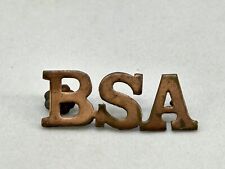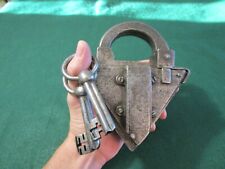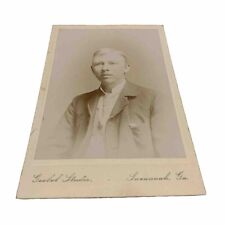When you click on links to various merchants on this site and make a purchase, this can result in this site earning a commission. Affiliate programs and affiliations include, but are not limited to, the eBay Partner Network.
This antique glass slide by T.H.McAllister is labeled \"E.R.BRIDGE.\" The East Rver Bridge later named the \"Brooklyn Bridge\" was completed in 1883 and this slide appears to date from around that time period. This interesting photograph was taken from the Manahattan side of the rive. The glass slide measures 3 1/4 x 4 inches. Very Good Condition! !Brooklyn BridgeFrom Wikipedia, the free encyclopediaJump to navigationJump to search
Brooklyn BridgeViewed fromManhattanin 2005Coordinates40.7057°N 73.9963°WCoordinates:40.7057°N 73.9963°WCarries6 lanes ofroadway(cars only)
Elevated trains(until 1944)
Streetcars(until 1950)
Pedestrians and bicyclesCrossesEast RiverLocaleNew York City(Civic Center,Manhattan–Dumbo/Brooklyn Heights,Brooklyn)Maintained byNew York City Department of TransportationID length5,989ft (1,825.4m)[2]Width85ft (25.9m)Height276.5ft (84.3m) above mean high water[3]Longest span1,595.5ft (486.3m)Clearance below135ft (41.1m)HistoryDesignerJohn Augustus RoeblingOpenedMay24, 1883; 135 years ago[4]StatisticsDaily traffic105,679 (2016)[5]TollFree both waysBrooklyn BridgeU.S. National Register of Historic PlacesU.S. National Historic LandmarkNYC datesAdded to NRHPOctober 15, 1966[6]DesignatedNHLJanuary 29, 1964[7]DesignatedNYCLAugust 24, 1967Brooklyn BridgeLocation in Lower ManhattanShow map of Lower ManhattanShow map of New York CityShow map of New YorkShow map of the USShow all
TheBrooklyn Bridgeis a hybridcable-stayed/suspension bridgeinNew York Cityand is one of the oldest roadwaybridgesin the United States. Started in 1869 and completed fourteen years later in 1883, it connects theboroughsofManhattanandBrooklyn, spanning theEast River. It has a main span of 1,595.5 feet (486.3m) and was the first steel-wire suspension bridge constructed. It was originally called theNew York and Brooklyn Bridgeand theEast River Bridge, but it was later dubbed the Brooklyn Bridge, a name coming from an earlier January 25, 1867 letter to the editor of theBrooklyn Daily Eagle[8]and formally so named by the city government in 1915. Since opening, it has become an icon of New York City and was designated aNational Historic Landmarkin 1964[7][9][10]and aNational Historic Civil Engineering Landmarkin 1972.[11]
Design
Although the Brooklyn Bridge is technically asuspension bridge,[12]it uses a hybridcable-stayed/suspension bridge design. The towers are built oflimestone,granite, andRosendale cement. The limestone was quarried at theClark QuarryinEssex County, New York.[13]The granite blocks were quarried and shaped onVinalhaven Island, Maine, under a contract with the Bodwell Granite Company, and delivered from Maine to New York by schooner.[14]
The bridge was built with numerous passageways and compartments in its anchorages. New York City rented out the large vaults under the bridge\'s Manhattan anchorage in order to fund the bridge. Opened in 1876, the vaults were used to store wine, as they were always at 60°F (16°C).[15]This was called the \"Blue Grotto\" because of a shrine to the Virgin Mary next to an opening at the entrance. WhenNew Yorkmagazine visited one of the cellars in 1978, it discovered on the wall a \"fading inscription\" reading: \"Who loveth not wine, women and song, he remaineth a fool his whole life long.\"[16]
HistoryConstructionJohn Augustus RoeblingEarly plan of one tower for the Brooklyn Bridge, 1867External videoPresentation by David McCullough onThe Great Bridge, September 17, 2002,C-SPAN
The bridge was conceived by German immigrantJohn Augustus Roeblingin 1852,[17]who spent part of the next 15 years working to sell the idea.[citation needed]He had previously designed and constructed shorter suspension bridges, such asRoebling\'s Delaware AqueductinLackawaxen, Pennsylvania, and theJohn A. Roebling Suspension BridgebetweenCincinnati, Ohio, andCovington, Kentucky. While conducting surveys for the bridge project, Roebling sustained a crush injury to his foot when aferrypinned it against apiling. After amputation of his crushed toes, he developed atetanusinfection that left him incapacitated and soon resulted in his death in 1869, not long after he had placed his 32-year-old son,Washington Roebling, in charge of the project.[18]
In February 1867, the New York State Senate passed a bill that allowed the construction of a suspension bridge from Brooklyn to Manhattan.[19]Two months later, the New York and Brooklyn Bridge Company was incorporated. The company was tasked with constructing what was then known as theNew York and Brooklyn Bridge.[20][21]
Construction of the Brooklyn Bridge began in 1869.[12]The bridge\'s two towers were built by floating twocaissons, giant upside-down boxes made ofsouthern yellow pine, in the span of the East River, and then beginning to build the stone towers on top of them until they sank to the bottom of the river. Compressed air was pumped into the caissons, and workers entered the space to dig the sediment, until the caissons sank to the bedrock. The whole weight of the bridge still sits upon 15-foot-thick southern yellow-pine wood under the sediment.[22]
Many workers became sick withthe bendsduring this work.[23]This condition was unknown at the time and was first called \"caisson disease\" by the project physician, Andrew Smith.[24][25]Washington Roebling suffered a paralyzing injury as a result of \"caisson disease\" shortly after ground was broken for the Brooklyn tower foundation on January 3, 1870.[26]Roebling\'s debilitating condition left him unable to physically supervise the construction firsthand.
As chief engineer, Roebling supervised the entire project from his apartment with a view of the work, designing and redesigning caissons and other equipment. He was aided by his wife,Emily Warren Roebling, who provided the critical written link between her husband and the engineers on site.[27]Warren Roebling studied highermathematics, calculations ofcatenarycurves, strengths of materials, bridge specifications, and intricacies of cable construction.[28][27][29]She spent the next 11 years helping to supervise the bridge\'s construction.
When iron probes underneath the caisson for the Manhattan tower found thebedrockto be even deeper than expected, Roebling halted construction due to the increased risk of decompression sickness. He later deemed the sandy subsoil overlying the bedrock 30 feet (9.1m) below it to be firm enough to support the tower base, and construction continued.[30]
The construction of the Brooklyn Bridge is detailed inThe Great Bridge(1972), the book byDavid McCullough[27], and inBrooklyn Bridge(1981), the firstPBSdocumentary film byKen Burns.[31]Burns drew heavily on McCullough\'s book for the film and used him as narrator.[32]It is also described inSeven Wonders of the Industrial World, a BBC docudrama series with an accompanying book.
OpeningThomas A. Edison, Inc.: \"New Brooklyn to New York Via Brooklyn Bridge\", 1899Newspaper headline announcing opening
The New York and Brooklyn Bridge was opened for use on May 24, 1883. Thousands of people attended the opening ceremony, and many ships were present in the East Bay for the occasion. PresidentChester A. ArthurandMayorFranklin Edsoncrossed the bridge to celebratory cannon fire and were greeted by Brooklyn MayorSeth Lowwhen they reached the Brooklyn-side tower. Arthur shook hands with Washington Roebling at the latter\'s home, after the ceremony. Roebling was unable to attend the ceremony (and in fact rarely visited the site again), but held a celebratory banquet at his house on the day of the bridge opening. Further festivity included the performance of a band, gunfire from ships, and a fireworks display.[33][34]Since the New York and Brooklyn Bridge was the only one across the East River at that time, it was also calledEast River Bridge.[35]
Chromolithographof the \"Great East River Suspension Bridge\", (Brooklyn Bridge), byCurrier and Ives, 1883.
On that first day, a total of 1,800 vehicles and 150,300 people crossed what was then the only land passage between Manhattan and Brooklyn. Emily Warren Roebling was the first to cross the bridge. The bridge\'s main span over the East River is 1,595 feet 6inches (486.3 m). The bridge costUS$15.5 millionin 1883 dollars (about US$393,964,000 in today\'s dollars) to build, and an estimated 27 men died during its construction.[36]
On May 30, 1883, six days after the opening, a woman falling down the stairway caused a stampede, which was responsible for at least twelve people being crushed and killed.[37]On May 17, 1884,P. T. Barnumhelped to squelch doubts about the bridge\'s stability—while publicizing his famous circus—when one of his most famous attractions,Jumbo, led a parade of 21 elephants over the Brooklyn Bridge.[38][39][40][41]
At the time it opened, and for several years, it was the longest suspension bridge in the world—50% longer than any previously built—and it has become a treasured landmark. Since the 1980s, it has been floodlit at night to highlight its architectural features. The architectural style isneo-Gothic, with characteristic pointed arches above the passageways through the stone towers. The paint scheme of the bridge is \"Brooklyn Bridge Tan\" and \"Silver\", although it has been argued that the original paint was \"Rawlins Red\".[42]
At the time the bridge was built, engineers had not yet discovered theaerodynamicsof bridge construction. Bridges were not tested inwind tunnelsuntil the 1950s, well after the collapse of the originalTacoma Narrows Bridge, known as Galloping Gertie, in 1940. It is therefore fortunate that the opentrussstructure supporting the deck is by its nature less subject to aerodynamic problems. Roebling designed a bridge and truss system that was six times as strong as he thought it needed to be. Because of this, the Brooklyn Bridge is still standing when many of the bridges built around the same time have vanished or been replaced. This is also in spite of the substitution of inferior quality wire in the cabling supplied by the contractorJ. Lloyd Haigh—by the time it was discovered, it was too late to replace the cabling that had already been constructed. Roebling determined that the poorer wire would leave the bridge four rather than six times as strong as necessary, so it was eventually allowed to stand, with the addition of 250 cables.
Later years[edit]
In 1915, the city government officially named the structure the \"Brooklyn Bridge\",[43]a name first mentioned in print in a January 1867 letter to the editor of theBrooklyn Daily Eagle.[44]
During theCold War, a fallout shelter was constructed beneath the Manhattan approach. The abandoned space in one of the masonry arches still contained the emergency survival supplies for a potential nuclear attack by theSoviet Unionwhen rediscovered in 2006 during a routine inspection.[45]
In 1964, the bridge was designated aNational Historic Landmark, having become an icon of New York City since its opening,[9][10]and aNational Historic Civil Engineering Landmarkin 1972.[11]
The centennial celebrations on May 24, 1983, saw a cavalcade of cars crossing the bridge, led by PresidentRonald Reagan. A flotilla of ships visited the harbor, parades were held, and in the evening the sky over the bridge was illuminated byGrucci Fireworks.[46]TheBrooklyn Museumexhibited a selection of the original drawings made for the bridge\'s construction, some by Washington Roebling. Media coverage of the centennial was declared \"the public relations triumph of 1983\" byInc.[47]
Beginning on May 22, 2008, five days of festivities celebrated the 125th anniversary of the bridge\'s opening. The events kicked off with a live performance of theBrooklyn PhilharmonicinEmpire–Fulton Ferry State Park, followed by special lighting of the bridge\'s towers and a fireworks display.[48]Other events held during the 125th anniversary celebrations, which coincided with theMemorial Dayweekend, included a film series, historical walking tours, information tents, a series of lectures and readings, a bicycle tour of Brooklyn, a miniature golf course featuring Brooklyn icons, and other musical and dance performances.[49]Just before the anniversary celebrations, artistPaul St Georgeinstalled theTelectroscope, a video link between New York City and London, on the Brooklyn side of the bridge. Theinstallationlasted for a few weeks and permitted viewers in New York City to see people looking into a matching telectroscope near London\'s Tower Bridge.[50]A newly renovated pedestrian connection tothe DUMBO neighborhoodwas also unveiled before the anniversary celebrations.[51]







